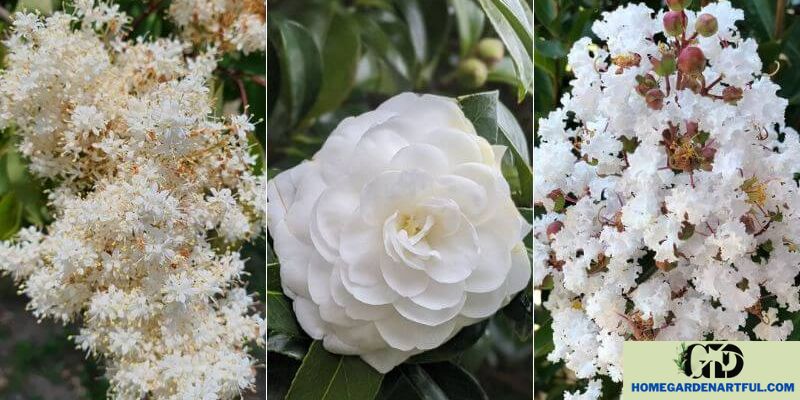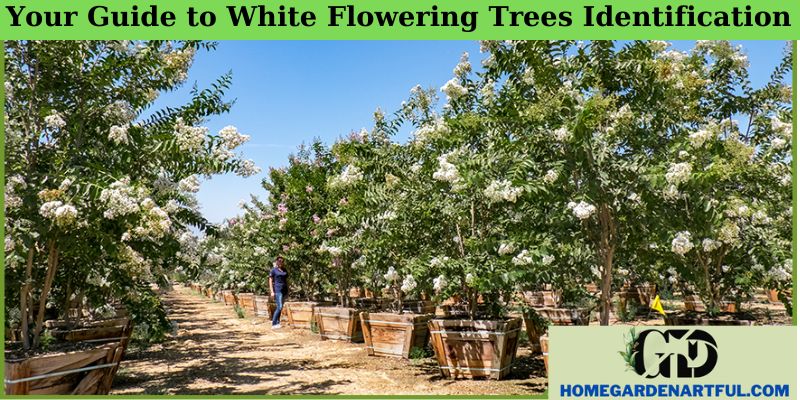White flowering trees are a stunning addition to any garden or landscape. With their delicate, elegant appearance, it’s no wonder they’re a favorite among gardeners and nature enthusiasts. However, with so many flowering tree species with white blossoms, identifying one from the other can be a challenge.
In this comprehensive guide, homegardenartful.com provide you with the knowledge and tools you need to recognize and distinguish between different types of white blossoming tree species. From understanding the characteristics of white-flowered trees to recognizing them through visual cues, you’ll be able to confidently identify and appreciate these beautiful trees.
Key Takeaways
- Identifying white flowering trees can be a challenge because of the large number of species with white blossoms.
- Understanding the characteristics of white-flowered trees and recognizing them through visual cues can help you distinguish between different species.
- By exploring the diversity of white flowering tree species, you can broaden your understanding and identification resources.
- Understanding the habitat and growth conditions of white flowering trees can further enhance your identification skills.
Understanding White Flowering Tree Characteristics
White-flowered tree varieties are found in various tree species with white flowers. These trees are known for their eye-catching, pristine white flowers that bloom in spring and summer. Some popular white flowering tree names include Dogwood, Magnolia, Cherry Blossom, and Pear. Identifying and differentiating white-flowered trees can be challenging due to their similarities, but understanding their unique characteristics can make the process easier.
One way of differentiating white-flowered trees is by examining their flowers. Some white-flowered trees have single-petal flowers, while others have double-petal flowers. A tree’s leaves can also provide clues as to its identity. For instance, the leaves of a Dogwood tree are oval-shaped, while those of a Magnolia tree are large and glossy. Identifying different white-flowered trees can also be done by examining the tree’s bark, branches, and overall shape.
Another characteristic to consider is the size of the tree. Some white-flowered tree varieties can grow up to 100 feet tall, while others are petite and perfect for small gardens or patios. Additionally, different white-flowered trees have varying lifespans. For example, Dogwood trees typically live for 30 to 40 years, while Cherry Blossoms can live for up to 100 years.
Understanding the unique characteristics of white-flowered trees can help you differentiate and identify different species. By examining the tree’s flowers, leaves, bark, branches, size, and lifespan, you can better determine its identity.
Recognizing White Flowering Trees Through Visual Cues
Identifying white-flowered trees can be challenging, particularly for those without a green thumb. However, understanding visual cues can help differentiate between species and make identification easier. Here are some white-flowered tree identification tips to keep in mind:

White Flowered Tree Examples
Examples of white flowering trees include dogwood, magnolia, cherry blossom, and apple blossom. These trees are often found in gardens, parks, and other green spaces, making them relatively easy to spot.
White-Petaled Tree Identification Tips
The most distinguishing feature of a white-flowered tree is, of course, its white petals. However, not all white petals are created equal. Some trees have large, showy petals, while others have small, delicate ones. Examining the shape and size of the petals can help narrow down the possible tree species.
White Flowering Tree Pictures
Visual aids like photos, diagrams, and illustrations can be incredibly useful when attempting to identify white-flowered trees. There are a number of online resources, such as arboretum websites or gardening forums, where you can find high-quality images of white-blooming trees. Additionally, books on tree identification often contain detailed pictures that can be helpful.
White-Flowered Tree Identification Methods
Another way to identify white-flowered trees is by examining other physical characteristics. For example, the shape of the leaves, the texture of the bark, and the overall size and shape of the tree can all provide clues as to the species. Consider seeking the advice of a local horticulturist or arborist who can help identify tree species in your area.
Exploring the Diversity of White Flowering Tree Species
White flowering trees are a diverse group of trees with unique characteristics and varied growth conditions. Understanding their diversity is key to identifying them accurately. In this section, we’ll delve into white petal tree species, flowering trees with white petals, white bloom tree classification, and white flowered tree identification resources.
White Petal Tree Species
White petal tree species are a group of flowering trees characterized by their delicate white petals. Some examples of white petal tree species include the dogwood tree, magnolia tree, and cherry blossom tree. These trees can be found in various parts of the world and are valued for their beautiful blooms and ornamental qualities.
Flowering Trees with White Petals
White-petaled flowers are a common trait among many types of flowering trees. Some examples of flowering trees with white petals include the apple tree, pear tree, and hawthorn tree. These trees are known for their fragrant blooms and fruit-bearing capabilities.
White Bloom Tree Classification
White bloom tree classification refers to the categorization of white flowering trees based on their botanical characteristics. Some common classifications of white bloom trees include deciduous, evergreen, and flowering. These classifications aid in accurately identifying white flowering trees based on their growth habits, leaf structure, and overall appearance.
White Flowered Tree Identification Resources
There are several resources available for identifying white flowered trees, including field guides, online databases, and botanical gardens. These resources can provide detailed information on white flowering tree species, their unique traits, and their natural habitats. Utilizing these resources can enhance your identification skills and deepen your knowledge of white flowering trees.
Understanding the Habitat and Growth Conditions of White Flowering Trees

White flowering trees are found in a variety of habitats and can thrive in different growth conditions. Understanding these factors can aid in identifying and cultivating white blossom trees.
| Habitat | Growth Conditions | Origins |
|---|---|---|
| Forests, woodlands, and meadows | Most species require full sun, moderate moisture, and well-drained soil | Native to Asia, Europe, North America, and other regions |
| Mountains and high-altitude regions | Thrive in cooler temperatures and can tolerate more extreme growing conditions | Certain species, such as the flowering dogwood, are native to the Appalachian Mountains |
| Coastal regions | Some species, such as the beach plum, can grow in saltwater environments and tolerate windy conditions | Many species, including the white magnolia, originated in Asia and were introduced to North America in the 18th century |
It’s important to note that not all white flowering trees have the same growing requirements, and it’s crucial to research each species’ specific needs before planting and cultivating them.
Conclusion
By now, you have gained a better understanding of white flowering trees and how to identify them. From recognizing their unique characteristics to understanding their habitats and growth conditions, you now have a robust toolkit to differentiate and classify various white-flowered tree species.
Remember, identifying white flowering trees requires attention to detail and a keen eye for visual cues. However, with practice and patience, you’ll soon be able to differentiate between various white-flowered tree species with ease.
Whether you’re a novice in the botanical world or an experienced botanist, this guide has provided you with valuable insights into these unique and delicate trees. Keep exploring and learning, and soon enough, you’ll be able to appreciate the beauty and diversity of white flowering trees around you.
FAQ
Q: How can I identify white flowering trees?
A: To identify white flowering trees, you can look for visual cues such as the color and shape of the flowers, the overall appearance of the tree, and any distinguishing characteristics. Additionally, you can consult identification resources or seek guidance from botanical experts.
Q: What are some examples of white flowering trees?
A: Some examples of white flowering trees include the dogwood tree, magnolia tree, cherry blossom tree, flowering pear tree, and jasmine tree.
Q: How do I differentiate between different white flowering tree species?
A: To differentiate between different white flowering tree species, you can examine the size, shape, and arrangement of the flowers, the leaf characteristics, the bark texture, and any other unique features specific to each species.
Q: Where can I find pictures of white flowering trees for identification?
A: There are various online resources, books, and botanical databases that provide pictures of white flowering trees for identification purposes. You can also visit botanical gardens or consult local arboretums for visual references.
Q: What are the habitat and growth conditions of white flowering trees?
A: The habitat and growth conditions of white flowering trees can vary depending on the species. Some white flowering trees thrive in temperate climates, while others prefer tropical or subtropical regions. They may require specific sunlight exposure, soil pH levels, and moisture conditions to grow healthily.


